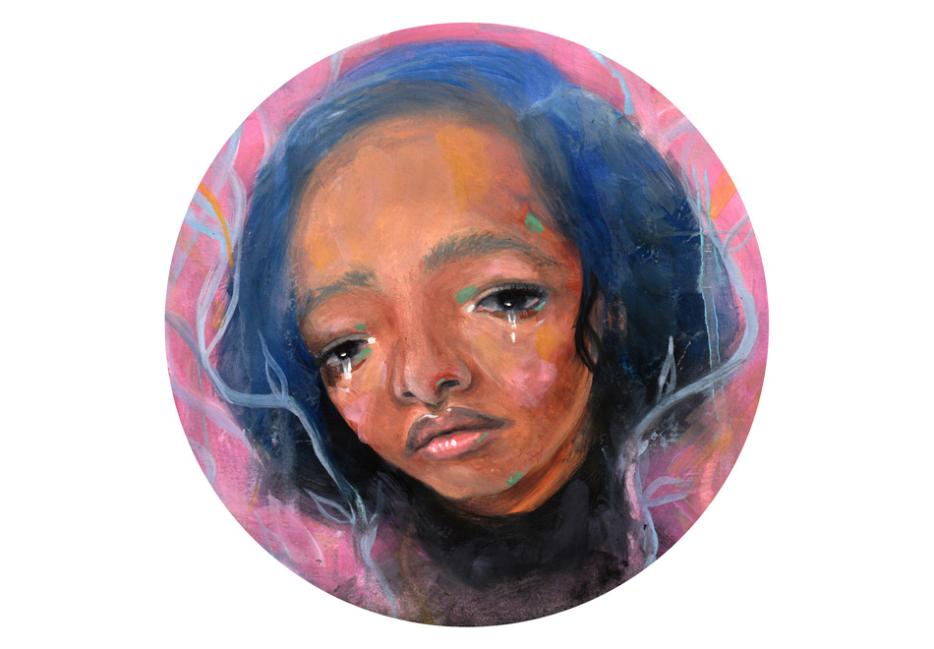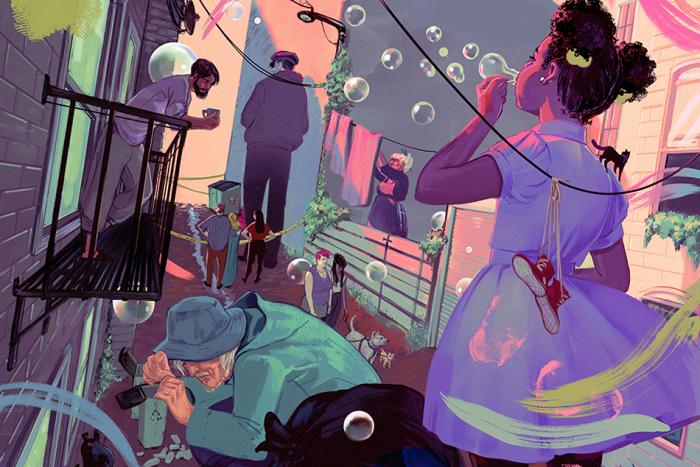Welcome to Untimely Meditations, a monthly column about fashion for people who hate fashion time, and are perpetually late.
There was a time when the French ruled the world. Now, it seems more like playacting. Enter #SadMacron, a collection of images from February and March that the internet memefied, poking fun at the French president’s seeming burlesque of seriousness. Taken by Macron’s official photographer, Soazig de la Moissonoière, the pictures show the president after a (seemingly fruitless?) conversation with the Russian president, Vladimir Putin. Missing his characteristic navy blue blazer, and attempting something that approximates human emotion, these images seek to launch Macron into the pantheon of historical importance.
For those of us who missed Cold War myth-making the first time around, the #SadMacron images are underwhelming updates to the genre. Stealing Kennedy valour, Macron goes for the just-add-water mystique of legacy building. He colourizes and reverses Jacques Lowe’s “The Loneliest Job,” a photograph that sees JFK turned away from the audience, without internalizing why that image works. Steadying himself on the resolute desk, caught between two flags—the symbol of the people on one side, and the symbol of the presidency on the other—Lowe’s interpretation of Kennedy hinges precisely on the tension between the president’s strong silhouette and the gravity of his office. Cutting a shadowy figure, Kennedy is armoured in a midcentury suit, the look calling to mind his wife Jackie’s plea to designer Oleg Cassini to “PROTECT ME.”
In contrast to Kennedy, Macron drops the jacket, and faces the audience, caught between nothing in particular. Bracketed by rococo cherubs, he is a “sober” intrusion into a world of pastels and gold. The removal of the suit jacket implies a “willingness to get down to work;” yet, without loosened tie or rolled up sleeves, it looks as if the president is posing. In other images of the #SadMacron series, we see furrowed brows and attempts at despair, all of which have the subtlety and range of a staged paparazzi shot. Yet, what is most compelling here is not what the president does or does not do, but rather the tension between the remnants of the Ancien Regime, and the codes of modernity, best exemplified through Macron’s crisp suit.
*
Unlike the gilded whimsy of an Ancien Regime interior, the contemporary suit means business. It is a triumph of the bourgeois mode over the aristocracy that came before it. Even without the accoutrements of work—namely, piles of papers, folders, and envelopes—the suit exudes seriousness. Changing little over centuries, the suit intrigues due to its simplicity of design, simultaneously obscuring and revealing the physique and character of its wearer, eschewing most ornamentation. For the architectural modernist, Adolf Loos, the suit was a holy garment. Per the fashion historian, Christopher Breward, Loos saw the suit as a “fundamental component of an enlightened existence…the suit had seemingly always been there to remind man of the responsibilities and prizes attached to his higher state.” It became the garment of masculine republicanism par excellence, with the psychologist J.C. Flügel remarking that it was a sign of “the great masculine renunciation,” which argued that from the late 18th century onwards, men abandoned the more ostentatious garments of the past, opting instead for sartorial minimalism. Flugel writes: “as commercial and industrial ideals conquered class after class, until they finally became accepted by the aristocracies of the more progressive countries, the plain and uniform costume associated with such ideals has, more and more, ousted the gorgeous and varied garments of the older order.”
Despite being called “Jupiter” in the French press—a veiled reference to both a god and the French king, Louis XIV—Macron is neither. His penchant for the suit reveals the heart of a bourgeois technocrat whose proximity to the Sun King perhaps comes from schoolboy imaginings, lofty ambitions, and a certain inflexibility of temperament. We accept gods and kings to be more opulent in their presentation, but the suit is often an exercise in restraint. In comparison to the gleam of the crown, the contemporary suit is aesthetically parsimonious. It is the stuff of clerks, industrialists, and civil servants—hardly ordained by god to govern, but apparently the market is fitting replacement. Yet, the suit—as we now know it—has its origins in Restoration-era England, a sartorial salve in an era of instability.
Though some date the birth of the suit to Revolutionary France and the Romantic era that succeeded it (or Beau Brummell, anyone?), the fashion historian David Kuchta argues that the three-piece suit emerges in the late 17th century, as a means of re-articulating aristocratic power following the English Civil War. Disagreeing with the “Great Masculine Renunciation” theory, Kuchta believes that the suit “shifted elite masculinity from a regime that valued sumptuous display as the privilege of nobility to one that rejected fashion as the concern of debauched upstarts,” instead inscribing modest consumption as a public virtue. And it started with a vest.
Introduced by King Charles II in 1666, the vest, per English diarist Samuel Pepys, was an attempt to “teach the nobility thrift” by introducing a style that “[they] will never alter.” Consciously unadorned, the vest meant to deflect from condemnations of English aristocratic excess made by radical reformers such as the Puritans. Per Kuchta, the vest could also be seen as a way for the English court to combat French influence by introducing a distinctly English style. Lord Halifax wrote that “[the English must] throw off [French] fashion, and put on vests, that we might look more like a distinct people, and not be under the servility of imitation.” This economic and political rivalry with France recast luxury and tyranny as distinctly “French vices” that the English imported—at their peril—through dress. As the poet Sir Thomas Overbury wrote, “vainglory, new fashions, and the French disease are upon terms of quitting their country’s allegiance, to be made free denizens of England.”
Sumptuary nationalism further solidified the trend, with wool becoming England’s “manly and moral fibre.” By 1688, extravagance in dress was seen as “base effeminacy,” with a gentleman’s reputation increasingly reliant on perceptions of their public piety, which was seen through the absence of adornment. By introducing the three-piece suit, the restoration court, according to Kuchta, “temporarily reversed the relation between power and display.” In forgoing obvious luxury, the crown regained its moral authority, and grounded it in a particular vision of masculinity—one that deliberately did away with the ornamentation of old.
*
English mores eventually found their way to France smuggled in the works of Enlightenment era thinkers like Voltaire. Entranced with English pragmatism, French fashion changed accordingly. It embraced English styles like the frock coat, gilet, and greatcoat, and according to the costume historian, Aileen Ribeiro, the Anglomania of the 1780s influenced French dress towards the sobriety of the black suit, a look “worn by middle class businessmen and the professional man—the lawyer, the doctor, the official—which was to become the urban dress of the nineteenth century man.” Yet, unlike the suit’s ability to unify at a time of social upheaval, Anglomania was a symptom of a society coming undone.
Another influence on the suit’s design were innovations in military dress. The uniform retrained and refit bodies and minds for combat, according to Breward in The Suit: Form, Function, and Style, “the military uniform was a potent agent of court and state control,” allowing for the expression of the staunch hierarchy of the Bourbon era state. It was a sensibility that continued throughout the French Revolution and into the Napoleonic era. Drawing on the historian Daniel Roche’s comments, Breward notes that “Uniform is at the heart of military logic…when war is a necessary continuation of politics. Uniform constructs the fighting man for mortal combat. It imposes control, a source of efficiency in battle and means to social power….it creates through education, realises a personage and affirms a political project by demonstrating omnipotence….uniform is central to a utopian and voluntarist vision of the social which reconciles the conflict between automatic docility ‘and the concrete economy of the individual liberty in which the autonomy of each constitutes the measure of his obedience.’ It impregnates the whole of society.” For revolutionaries in particular, English style suits became the antithesis of aristocratic opulence; the simplicity and rigorousness of its tailoring made it the perfect assertion of the new order.
Countering the tyranny of an immaculately baubled aristocracy, the suit was infused with the austere self-confidence of neoclassicism—a new masculinity. As Barbara Vinken writes in “What Fashion Strictly Divided,” the Revolution did away with the sybaritic noble, reducing their symbolic power to mere trinket, instead promoting “the citizen-man—the only real man—[who] stands in a negative relation to the world of frivolous appearance. He is. He does need to represent.” The suit was no mere uniform, it became, in Roche’s view, part of a new delineation of public space, [establishing] distances, a code of human and social relations, and it was all the more persuasive in that it developed an aesthetic.”
*
On March 14th, Macron swapped Kennedy-core for purposeful schlubbiness. Emerging for the press in jeans and a black French special forces hoodie, he looked uncharacteristically casual. Instead of memes, the internet noted a curious similarity between Macron’s new look and that of the Ukrainian president Volodymyr Zelenskyy, war hero du jour. As Oleksiy Sorokin of the Kiev Independent quipped on Twitter: “A month ago it would have been hard to imagine French President Emmanuel Macron trying to copy President Volodymyr Zelenskyy. Now it’s the reality we live in.”
Compared to Zelenskyy’s man-of-the-people greens, Macron’s new look reads as army man cosplay. It’s odd that the avatar of the “Jupiterian presidency” would even deign to be perceived in sweats. Stranger still is that anyone remotely deserving of a mythological moniker would dress like a post-Gordon Geckko style corporate raider devoid of sleaze and personality. Nevertheless, he persisted. Relatability gambits will never die.
Though the internet lambasted Macron’s jeans-and-a-hoodie as an attempt to copy Ukraine’s wartime leader, his look was less post-Maidan everyman, and more 2000s tech bro. A fashion revolution of a different kind, the tech bro uniform of t-shirts, jeans, hoodies, and Patagonia vests implied the same Protestant impulses as the proto-suit, with a decidedly amoral twist. Uninterested in the hereafter or any particular religious statement (unless relentless optimizing and money is your god), its “dogma,” wrote Hannah Murphy in the Financial Times, is that “minimalism and monotony yield extra productivity.”
Social media titan Mark Zuckerberg famously stated, regarding the monotonousness of his dress, that his intention was to “clear [his] life to make it so that [he had] to make as few decisions as possible about anything except how best to serve [the Facebook] community.” He continued: “I feel like I’m not doing my job if I spend any of my energy on things that are silly or frivolous about my life.” Though he shed the suit, he never shed one of the most potent ideas behind it; that you are what you do, not what you appear to be.
By relentlessly simplifying until there’s barely anything left and posturing at a kind of anti-fashion, the tech bro uniform undermines the suit’s potency, highlighting in the latter a kind of stuffy pomposity and lack of intellectual rigour. This sentiment calls to mind Silicon Valley investor Peter Thiel’s disdain for CEOs in suits. As he wrote in Zero to One regarding how his company chooses to invest: “pass on any company whose founders dressed up for pitch meetings.”
It’s a similar logic that underpinned criticisms of French aristocratic fashion during the French Revolution; if you are what you say you are, contend the investor and the critic, then why are you laden down with needless accoutrements? If power in Silicon Valley derives from mental acuity and obsessiveness, slickness and attention to detail in dress suggests a lack of intellectual virility; a need to preen and pose, and a lack of attention to what really matters, vision and code. As Thiel wrote, “there’s nothing wrong with a CEO who can sell, but if he actually looks like a salesman, he’s probably bad at sales and worse at tech.”
The tech bro uniform suggests a shift in where real power lies. The symbols of the past cannot hold. Instead, power belongs to those who create and control the attention economy: tech titans, and those best placed to surf the fickle waves of the discourse. You don’t have to be perfect, you just have to seem “real,” or at the very least, “disruptive.” That’s something that the likes of Zuckerberg got, and what Zelenskyy in his army greens understands.
Perhaps it’s fitting then that Macron aimed for war hero and emerged instead as dweeby tech despot. Thank god he didn’t go for a vest, bulletproof, Patagonia or otherwise. After all, we’re in the midst of a social media war—where it’s as much about creating spectacle as it is combating it. So why not pay tribute to those who ultimately shape what and how we see? Why not don the guise of the new gods? Jupiter is so passé.






